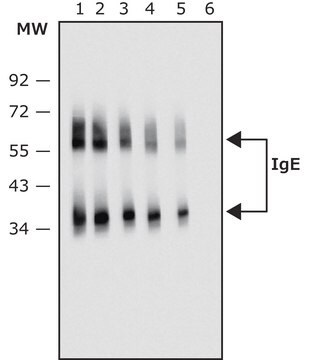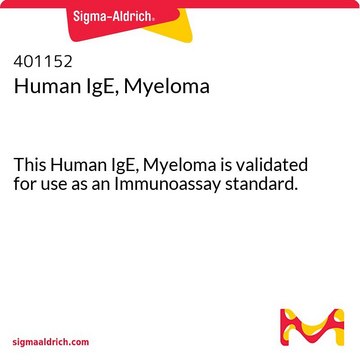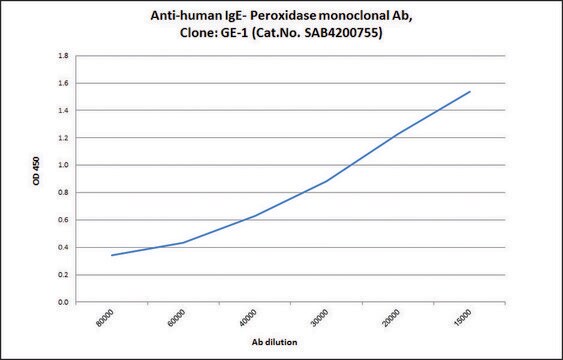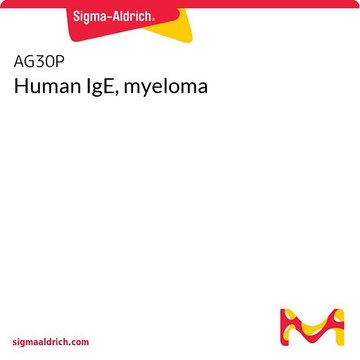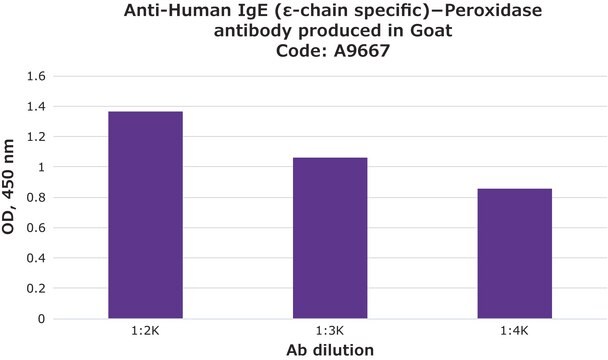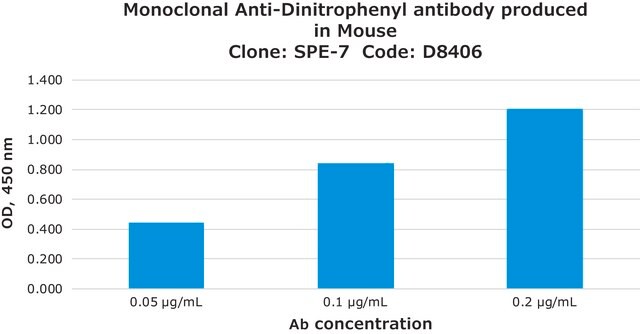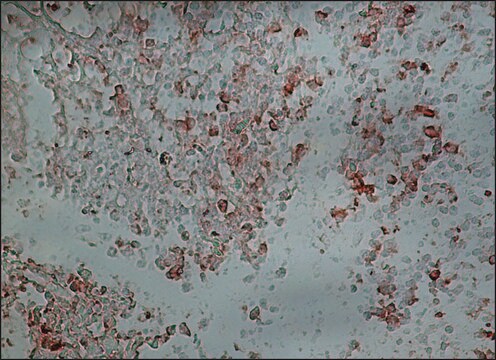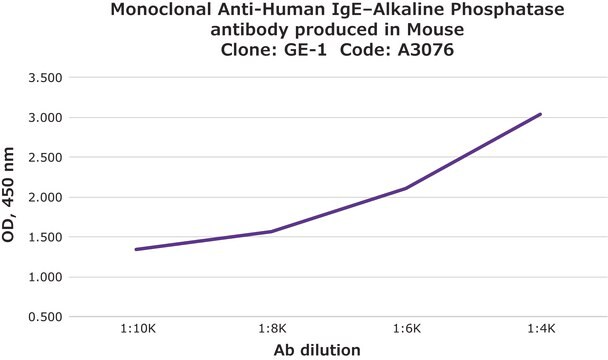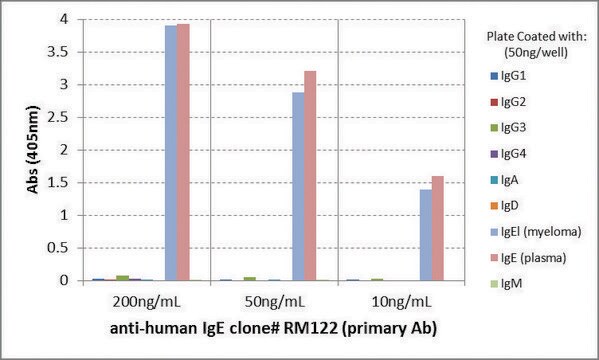I6510
Monoclonal Anti-Human IgE antibody produced in mouse
clone GE-1, ascites fluid
Sinonimo/i:
Monoclonal Anti-Human IgE
Autenticatiper visualizzare i prezzi riservati alla tua organizzazione & contrattuali
About This Item
Codice UNSPSC:
12352203
NACRES:
NA.46
Prodotti consigliati
Origine biologica
mouse
Coniugato
unconjugated
Forma dell’anticorpo
ascites fluid
Tipo di anticorpo
secondary antibodies
Clone
GE-1, monoclonal
contiene
15 mM sodium azide
tecniche
indirect ELISA: 1:5,000
Isotipo
IgG2b
Condizioni di spedizione
dry ice
Temperatura di conservazione
−20°C
modifica post-traduzionali bersaglio
unmodified
Cerchi prodotti simili? Visita Guida al confronto tra prodotti
Descrizione generale
Binds human IgE; does not bind human IgG, IgA or IgM.
Monoclonal Anti-Human IgE (mouse IgG2b isotype) is derived from the hybridoma produced by the fusion of mouse myeloma cells and splenocytes from an immunized mouse. Immunoglobulin E (IgE) antibodies are tetramers with two light chains (κ or λ) and two ε-heavy connected by numerous intrachain disulfide bonds. IgE exists in two isoforms, one is associated with the B cell receptor and the other being secreted by plasma cell. It has a short life span in plasma when compared to receptor bounded IgE.
Specificità
Monoclonal Anti-Human IgE is immunospecific for human IgE. No cross-reactivity with human IgG, IgM or purified light chains is observed.
Applicazioni
To confirm that a chimaeric monoclonal antibody had episolon chain, an elisa was performed using monoclonal anti-human IgE antibody (clone GE1) at a 1:1000 dilution.
Azioni biochim/fisiol
Immunoglobulin E (IgE) is implicated in acute allergic reactions and chronic inflammatory allergic diseases, such as allergic asthma and chronic urticaria (CU). Receptor bounded IgE aids antigen uptake and modulates the differentiation and proliferation of B cells. It confers immunity against helminthic parasites. IgE is also involved in facilitating type I hypersensitivity reactions. It regulates mast cell homeostasis and also exhibits immunomodulatory effects.
Stato fisico
The product is provided as ascites fluid with 0.1% sodium azide as a preservative.
Stoccaggio e stabilità
For continuous use, store at 2-8 °C for up to one month. For extended storage, the solution may be frozen in working aliquots. Repeated freezing and thawing is not recommended. Storage in "frost-free" freezers is not recommended. If slight turbidity occurs upon prolonged storage, clarify the solution by centrifugation before use.
Risultati analitici
The antibody is tested for reactivity against myeloma IgE and allergy-elevated IgE.
Esclusione di responsabilità
Unless otherwise stated in our catalog or other company documentation accompanying the product(s), our products are intended for research use only and are not to be used for any other purpose, which includes but is not limited to, unauthorized commercial uses, in vitro diagnostic uses, ex vivo or in vivo therapeutic uses or any type of consumption or application to humans or animals.
Non trovi il prodotto giusto?
Prova il nostro Motore di ricerca dei prodotti.
Codice della classe di stoccaggio
10 - Combustible liquids
Classe di pericolosità dell'acqua (WGK)
nwg
Punto d’infiammabilità (°F)
Not applicable
Punto d’infiammabilità (°C)
Not applicable
Scegli una delle versioni più recenti:
Possiedi già questo prodotto?
I documenti relativi ai prodotti acquistati recentemente sono disponibili nell’Archivio dei documenti.
I clienti hanno visto anche
X Su et al.
Analytical biochemistry, 273(1), 66-72 (1999-08-24)
This work presents a piezoelectric (Pz) immunosensor for the quantification of total human IgE in serum samples. The anti-human IgE is deposited on the surface of the 10 M Hz AT-cut gold coated crystal resonator by self-assembled technique, and serves
Jessy Elst et al.
Methods in molecular biology (Clifton, N.J.), 2163, 213-218 (2020-08-09)
The basis of traditional flow cytometry allergy diagnosis is measurement of the expression of basophilic surface activation and/or degranulation markers. Basophils, upon encounter with a specific allergen that cross-links surface FcRI-bound IgE antibodies, not only secrete and release quantifiable bioactive
P Demoly et al.
Clinical and experimental allergy : journal of the British Society for Allergy and Clinical Immunology, 32(7), 1071-1076 (2002-07-09)
Cupressaceae pollen allergy is a world-wide pollinosis but immunotherapy has rarely been tested. Immunotherapy is usually allergen-specific but new forms may be targeted towards IgE. A randomized, double-blind, placebo-controlled trial was carried out to assess the efficacy of a vaccine
Hans C Oettgen
The Journal of allergy and clinical immunology, 137(6), 1631-1645 (2016-06-07)
Fifty years ago, after a long search, IgE emerged as the circulating factor responsible for triggering allergic reactions. Its extremely low concentration in plasma created significant hurdles for scientists working to reveal its identity. We now know that IgE levels
Arnau Navinés-Ferrer et al.
Journal of immunology research, 2016, 8163803-8163803 (2017-01-18)
IgE is an immunoglobulin that plays a central role in acute allergic reactions and chronic inflammatory allergic diseases. The development of a drug able to neutralize this antibody represents a breakthrough in the treatment of inflammatory pathologies with a probable
Il team dei nostri ricercatori vanta grande esperienza in tutte le aree della ricerca quali Life Science, scienza dei materiali, sintesi chimica, cromatografia, discipline analitiche, ecc..
Contatta l'Assistenza Tecnica.